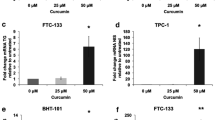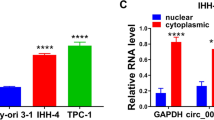Abstract
Anaplastic thyroid carcinoma (ATC) is the most aggressive malignancy in thyroid cancers. Resistance to current therapies is still a challenge. MicroRNAs are a class of small non-coding RNAs, regulating gene expression. MiR-21 is an oncomiR that is overexpressed in nearly all cancers including ATC. Accumulating evidence suggested that miR-21 has a role in cancer stemness state, apoptosis, cell cycle progression, and differentiation. Therefore, we evaluated the application of Off-miR-21 to sequester the microRNA for therapeutic purposes on ATC cell lines. In this study, C643 and SW1736 were transducted by hsa-miR-21 antagomir (Off-miR-21). PTEN gene expression was performed as a known target of miR-21. Stemness state in cancer stem cells (CSCs) was evaluated by the changes of CSC biomarkers including Oct-4 and ABCG2. Apoptosis was assessed by PDCD4 and Mcl-1 gene expression and flow cytometry. Sodium/iodide symporter (NIS) and thyroglobulin (TG) were measured as ATC differentiation markers. In addition, cell cycle progression was investigated via the alterations of p21 gene expression and flow cytometry. Specific downregulation of miR-21 induced the differentiation and apoptosis in C643 and SW1736. Inversely, the treatment inhibited stemness state and cell cycle progression. Knockdown of miR-21 significantly increased the expression of PDCD4, p21, NIS, and TG while leading to decreased expression of Oct-4, ABCG2, and Mcl-1.Taken together, the results suggest that miR-21, as an oncomiR, has a role not only in stemness state but also in tumor growth, differentiation, and apoptosis. Hence, suppression of miR-21 could pave the way for ATC therapy.





Similar content being viewed by others
References
Sipos J, Mazzaferri E. Thyroid cancer epidemiology and prognostic variables. Clin Oncol. 2010;22:395–404.
Davies L, Welch HG. Increasing incidence of thyroid cancer in the United States, 1973–2002. JAMA. 2006;295:2164–7.
Pierie J-PE, Muzikansky A, Gaz RD, Faquin WC, Ott MJ. The effect of surgery and radiotherapy on outcome of anaplastic thyroid carcinoma. Ann Surg Oncol. 2002;9:57–64.
Reya T, Morrison SJ, Clarke MF, Weissman IL. Stem cells, cancer, and cancer stem cells. Nature. 2001;414:105–11.
Guo Z, Hardin H, Lloyd RV. Cancer stem-like cells and thyroid cancer. Endocr Relat Cancer. 2014;21:T285–300.
Ma R, Minsky N, Morshed SA, Davies TF. Stemness in human thyroid cancers and derived cell lines: the role of asymmetrically dividing cancer stem cells resistant to chemotherapy. J Clin Endocrinol Metab. 2014;99:E400–E9.
Lin RY. Thyroid cancer stem cells. Nat Rev Endocrinol. 2011;7:609–16.
Gao Y-J, Li B, Wu X-Y, Cui J, Han J-K. Thyroid tumor-initiating cells: increasing evidence and opportunities for anticancer therapy (review). Oncol Rep. 2014;31:1035–42.
Xing M. Genetic alterations in the phosphatidylinositol-3 kinase/Akt pathway in thyroid cancer. Thyroid. 2010;20:697–706.
Hill R, Wu H. PTEN, stem cells, and cancer stem cells. J Biol Chem. 2009;284:11755–9.
Riesco-Eizaguirre G, Santisteban P. A perspective view of sodium iodide symporter research and its clinical implications. Eur J Endocrinol. 2006;155:495–512.
Paes JE, Ringel MD. Dysregulation of the phosphatidylinositol 3-kinase pathway in thyroid neoplasia. Endocrinol Metab Clin North Am. 2008;37:375–87.
Song MS, Salmena L, Pandolfi PP. The functions and regulation of the PTEN tumour suppressor. Nat Rev Mol Cell Biol. 2012;13:283–96.
Samimi H, Zaki dizaji M, Ghadami M, Shahzadeh fazeli A, Khashayar P, Soleimani M, et al. MicroRNAs networks in thyroid cancers: focus on miRNAs related to the fascin. J Diabetes MetabDisord. 2013;12:31.
Selcuklu SD, Donoghue MA. Spillane C: miR-21 as a key regulator of oncogenic processes. Biochem Soc Trans. 2009;37:918–25.
Galderisi U, Cascino A, Giordano A. Antisense oligonucleotides as therapeutic agents. J Cell Physiol. 1999;181:251–7.
Naldini L, Blömer U, Gallay P, Ory D, Mulligan R, Gage FH, et al. In vivo gene delivery and stable transduction of nondividing cells by a lentiviral vector. Science. 1996;272:263–7.
Naderi M, Abdul TH, Soleimani M, Shabani I, Hashemi SM: A home-brew real-time PCR assay for reliable detection and quantification of mature miR-122. Appl Immunohistochem Mol Morphol 2014.
Samimi H, Zaki dizaji M, Ghadami M, Shahzadeh fazeli A, Khashayar P, Soleimani M, et al. Essential genes in thyroid cancers: focus on fascin. J Diabetes MetabDisord. 2013;12:32.
Kang HY. MicroRNA-21 regulates stemness in cancer cells. Stem Cell Res Ther. 2013;4:110–3.
Schweppe RE, Klopper JP, Korch C, Pugazhenthi U, Benezra M, Knauf JA, et al. Deoxyribonucleic acid profiling analysis of 40 human thyroid cancer cell lines reveals cross-contamination resulting in cell line redundancy and misidentification. J Clin Endocrinol Metab. 2008;93:4331–41.
Meireles AM, Preto A, Rocha AS, Rebocho AP, Máximo V, Pereira-Castro I, et al. Molecular and genotypic characterization of human thyroid follicular cell carcinoma-derived cell lines. Thyroid. 2007;17:707–15.
Pilli T, Prasad KV, Jayarama S, Pacini F, Prabhakar BS. Potential utility and limitations of thyroid cancer cell lines as models for studying thyroid cancer. Thyroid. 2009;19:1333–42.
Altmann A, Markert A, Askoxylakis V, Schöning T, Jesenofsky R, Eisenhut M, et al. Antitumor effects of proteasome inhibition in anaplastic thyroid carcinoma. J Nucl Med. 2012;53:1764–71.
Thomas T, Nowka K, Lan L, Derwahl M. Expression of endoderm stem cell markers: evidence for the presence of adult stem cells in human thyroid glands. Thyroid. 2006;16:537–44.
Niwa H, Miyazaki J-I, Smith AG. Quantitative expression of Oct-3/4 defines differentiation, dedifferentiation or self-renewal of ES cells. Nat Genet. 2000;24:372–6.
Zheng X, Cui D, Xu S, Brabant G, Derwahl M. Doxorubicin fails to eradicate cancer stem cells derived from anaplastic thyroid carcinoma cells: characterization of resistant cells. Int J Oncol. 2010;37:307–15.
Fierabracci A. Identifying thyroid stem/progenitor cells: advances and limitations. J Endocrinol. 2012;213:1–13.
Kogai T, Taki K, Brent G. Enhancement of sodium/iodide symporter expression in thyroid and breast cancer. Endocr Relat Cancer. 2006;13:797–826.
Lan L, Cui D, Nowka K, Derwahl M. Stem cells derived from goiters in adults form spheres in response to intense growth stimulation and require thyrotropin for differentiation into thyrocytes. J Clin Endocrinol Metab. 2007;92:3681–8.
Lankat-Buttgereit B, Göke R. Programmed cell death protein 4 (pdcd4): a novel target for antineoplastic therapy? Biol Cell. 2003;95:515–9.
Asangani I, Rasheed S, Nikolova D, Leupold J, Colburn N, Post S, et al. MicroRNA-21 (miR-21) post-transcriptionally downregulates tumor suppressor Pdcd4 and stimulates invasion, intravasation and metastasis in colorectal cancer. Oncogene. 2008;27:2128–36.
Nijhawan D, Fang M, Traer E, Zhong Q, Gao W, Du F, et al. Elimination of Mcl-1 is required for the initiation of apoptosis following ultraviolet irradiation. Genes Dev. 2003;17:1475–86.
Fernald K, Kurokawa M. Evading apoptosis in cancer. Trends Cell Biol. 2013;23:620–33.
Stiles B, Groszer M, Wang S, Jiao J, Wu H. PTENless means more. Dev Biol. 2004;273:175–84.
Fata JE, Debnath S, Jenkins EC, Fournier MV. Nongenomic mechanisms of PTEN regulation. Int J Cell Biol. 2012;2012:379685.
Buscaglia L, Li Y. Apoptosis and the target genes of microRNA-21. Chin J Cancer. 2011;30:371–80.
Abbas T, Dutta A. p21 in cancer: intricate networks and multiple activities. Nat Rev Cancer. 2009;9:400–14.
Smallridge RC, Marlow LA, Copland JA. Anaplastic thyroid cancer: molecular pathogenesis and emerging therapies. Endocr Relat Cancer. 2009;16:17–44.
Nijhawan D, Fang M, Traer E, Zhong Q, Gao W, Du F, et al. Sorafenib inhibits intracellular signaling pathways and induces cell cycle arrest and cell death in thyroid carcinoma cells irrespective of histological origin or BRAF mutational status. BMC Cancer. 2015;15:184.
Acknowledgments
The authors would like to thank Stem Cell Technology Research Center and Nuclear Medicine Research Center at Shariati Hospital which supported some parts of the experiments. The authors would like to acknowledge the assistance of Dr. Marzieh Ebrahimi, Dr. Mahin Nikogoftar, Dr. Amir Atashi, Mr. Mohsen Malehmir, and Mr. Majid Zakidizaji for their scientific advice and Dr. Mohsen Khorashadizadeh, Dr. Navid Madani, Prof. Anooshirvan Hedayat, Mr. Ehsan Janzamin, Mr. Fazel Samani, and Ms. Azadeh Anbarlou for their technical advice and support.
Funding
This project has been funded by National Elite Foundation of Allameh Tabatabai grant (BN012) and Endocrinology and Metabolism Research Institute, Tehran University of Medical Sciences.
Conflicts of interest
None
Ethical approval
This article does not contain any studies with human participants or animals performed by any of the authors.
Author information
Authors and Affiliations
Corresponding author
Rights and permissions
About this article
Cite this article
Haghpanah, V., Fallah, P., Tavakoli, R. et al. Antisense-miR-21 enhances differentiation/apoptosis and reduces cancer stemness state on anaplastic thyroid cancer. Tumor Biol. 37, 1299–1308 (2016). https://doi.org/10.1007/s13277-015-3923-z
Received:
Accepted:
Published:
Issue Date:
DOI: https://doi.org/10.1007/s13277-015-3923-z




